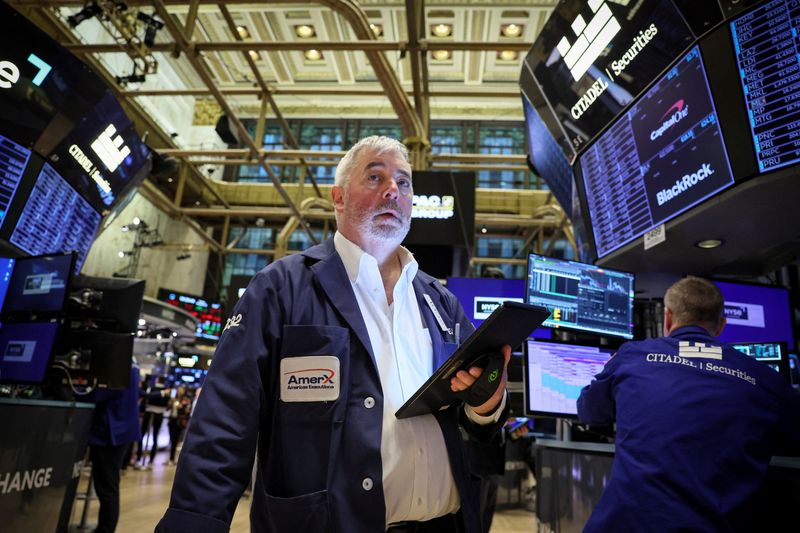By Stephen Culp
NEW YORK (Reuters) - Wall Street stocks edged higher on Monday as benchmark U.S. Treasury yields backed down from 5% and investors shifted their focus to this week's high profile earnings and closely watched economic data.
All three major U.S. stock indexes reversed an earlier dip as the 10-year U.S. Treasury yield eased, boosting a host of interest rate sensitive momentum stocks of companies slated to report second-quarter financial results this week.
"Investors are of the opinion that the 10-year (Treasury yield) has peaked or is likely to peak," said Sam Stovall, chief investment strategist of CFRA Research in New York.
"We've seen the market do so poorly the last week, it could simply be a reflex action, a counter-trend rally that might last for only a day, because there's a lot of data this week, GDP in particular."
The S&P 500 index was last trading right at the 200-day moving average, an important support level, after closing below it on Friday.
The tech-heavy Nasdaq Composite Index was up most while the blue-chip Dow Jones Industrial Average was last nominally lower.
The week ahead promises to be eventful for earnings, with reports by nearly one-third of the companies in the S&P 500.
These include megacap momentum drivers, including Microsoft Corp (NASDAQ:MSFT), Alphabet (NASDAQ:GOOGL) Inc, Meta Platforms Inc and Amazon.com (NASDAQ:AMZN), along with heavy-hitting industrials such as General Motors Co (NYSE:GM), Ford Motor (NYSE:F) Co and Boeing (NYSE:BA) Co.
"With nearly a third of the S&P reporting this week, investors are hoping these 'magnificent seven' companies will end up surprising to the upside," Stovall said.
So far, 86 of the companies in the S&P 500 have posted earnings. Of those, 78% have beat expectations, LSEG data showed.
Analysts currently see aggregate S&P 500 earnings for the July-September period growing 1.2% year-on-year, slightly below the 1.6% growth projected at the start of the month, according to LSEG.
The Commerce Department on Thursday will announce third-quarter gross domestic product, seen accelerating to 4.3%. Its wide-ranging Personal Consumption Expenditures (PCE) report due on Friday, is expected to show annual headline and core inflation cooling down to 3.4% and 3.7%, respectively.
Geopolitical turmoil is also on the radar, with market participants looking for potential signs the Israel-Hamas conflict could broaden or escalate.
The Dow Jones Industrial Average fell 7.4 points, or 0.02%, to 33,119.88, the S&P 500 gained 19.06 points, or 0.45%, to 4,243.22 and the Nasdaq Composite added 128.25 points, or 0.99%, to 13,112.06.
Of the 11 major sectors in the S&P 500, communication services were up most, while energy shares suffered the largest percentage drop.
Walgreens Boots Alliance (NASDAQ:WBA) surged 4.8% after J.P. Morgan upgraded the pharmacy chain operator to "overweight" from "neutral."
Chevron (NYSE:CVX) fell 3.2% after the company said it would buy smaller rival Hess Corp (NYSE:HES) in a $53 billion all-stock deal. Hess was off 0.5%.
Agricultural sciences firm FMC fell 11.7% after the company lowered its third-quarter revenue and earnings outlook.

Declining issues outnumbered advancers on the NYSE by a 1.14-to-1 ratio; on Nasdaq, a 1.17-to-1 ratio favored decliners.
The S&P 500 posted one new 52-week high and 52 new lows; the Nasdaq Composite recorded 10 new highs and 428 new lows.